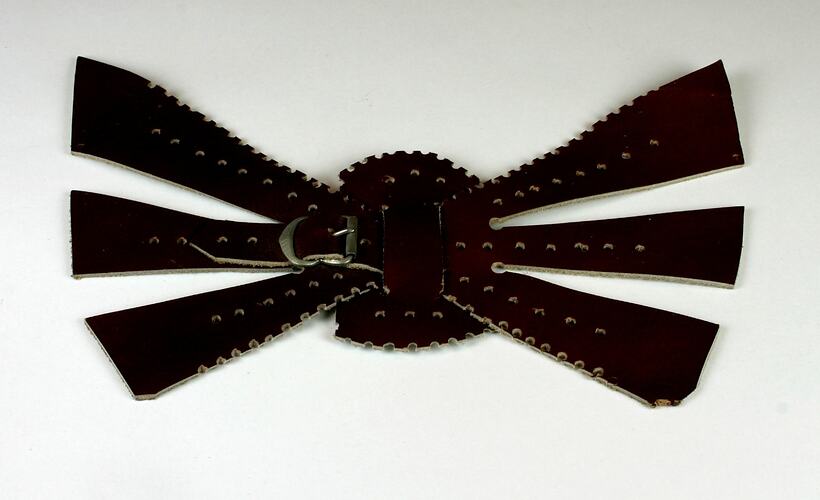Summary
This dark brown coloured leather sample, with its punched central leather disc and buckle, and six branching leather straps was created by Stanio Fancoff sometime between 1930s and the 1970s. This particular leatherwork sample indicates both leather colour and a particular ornate decorative pattern style. Along with many other leatherworking samples, this leather sample was most likely shown to prospective purchasers as examples of Stanio's shoeware styles which were made from his shoemaking business in Fitzroy by himself and family.
Stanio Ivanoff Fancoff was born in 1908 in Bojentsi, a small village in Bulgaria. At age 11, Stanio left home to learn the shoemaking trade. In 1929, he immigrated to Melbourne, settled in Fitzroy and began to work for the V.G. Zemancheff & Sons basket shoe factory in South Melbourne. In1936, he married Dorotea Georgi Touzou who had recently arrived in Australia. Around this time, Stanio set up his own shoemaking business from home, with Georgi, her cousin and sister weaving the shoes which he then assembled. Select shoe samples were then taken to Sydney and Tasmania for sale. In 1942, Georgi and Stanio moved to Broken Hill for Georgi's health; there daughter Nancy was born and Stanio set up a shoe shop/factory. In 1945, Georgi died and by 1950 Stanio and Nancy had moved to Adelaide where he again opened a shoemaking business and shop. He passed away in 1978, having been in the shoemaking business for 59 years. This collection documents his migration and working life experiences.
Physical Description
Dark tan leather sample, created from a two piece construction. First, the central oval disc appears with its vertical sides cut straight. The disc is adorned by three hole punches both top and botton, plus the top and bottom edges have been half-punched to provide an ornate edge-line. Measuring 4.2 x 8cm, this disc has two parallel slit lines running lengthwise, that allow the secondary piece construction to sit within and attach. The secondary construction piece is created in the same leather as the central disc. Attaching through the central disc slot, each side of this secondary piece has three leather projections, totally six in all. The top projects have eight holes punched along a central line, the second row of projections has seven holes punched, whilst the lower right has seven holes and the lower left retains six central lined punched holes. In addition, the left middle projection has an additional leather overlap in which a plain silver buckle fastens. Similar to the central disc, the inner top and inner bottom edges of the secondary piece have been half-punched to create an ornate edgeline. All holes punched appear within an evenly spaced and uniform format. While the leather's front side appears smooth with a slight sheen, the reverse side exhibits the skin's natural fibres.
Significance
This collection is significant in documenting a small migrant business as well as the fashion of a particular period. It is well provenanced and charts the application of trade skills in a new country. It also illustrates the stages of hand shoe manufacture from the 1930s, demonstrating the enduring nature of the tools and patterns that were used.
More Information
-
Collecting Areas
-
Acquisition Information
Donation from Nancy Vasileff, 21 Mar 2007
-
Maker
-
Classification
-
Category
-
Discipline
-
Type of item
-
Overall Dimensions
227 mm (Length), 150 mm (Width)
-
References
R.A. Salaman, 'Dictionary of Leather-working Tools c.1700-1950 and Tools of Allied Trades,' London: George Allen and Unwin (Publishers) Ltd, 1986 [Section 2: Boot and Shoe Maker pp18-185]. John Peacock. 'Shoes, The Complete Sourcebook,' London:Thames & Hudson Ltd, 2005. NAA holds file (online) on Vasil George Zemancheff, Fancoff's employer
-
Keywords
Boot & Shoemaking, Bulgarian Communities, Bulgarian Immigration, Immigration, Small Businesses, Tools

